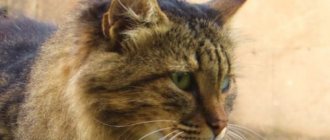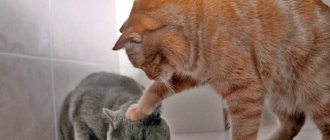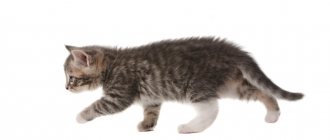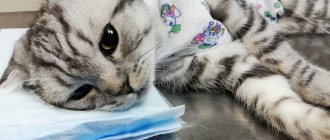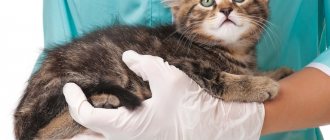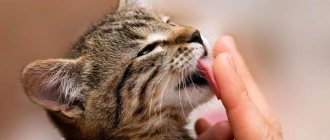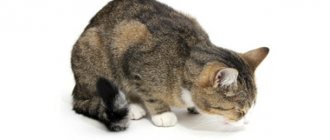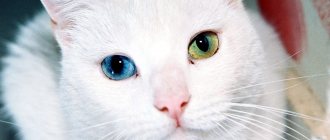5037Pavel
Representatives of the feline species spend most of their lives sleeping. These animals love to settle down in a cozy, safe place and choose the most comfortable position. Sometimes a cat twitches in its sleep. A person, seeing such movements, often begins to worry and wonders whether such a phenomenon is normal. What happens to an animal during sleep? What kind of movements during rest can be evidence of the development of pathologies? The answers to such questions are most interesting and important for animal owners.
Sleep Features
- Experts constantly study the behavior of furry animals, so they made conclusions regarding the sleep phases of cats. The first stage includes sleep of a superficial type, which is comparable to dozing. The animal controls its actions because the body does not relax completely. The pet is aware of what is happening around it and can stand up or open its eyes at any time.
- The second phase includes slow-moving sleep. It is characterized by relaxation of muscle fibers, a decrease in blood circulation, and a slowdown in heart rate and breathing. The individual may open its eyes slightly, as if fighting sleep, then close them again. Everything is done very slowly.
- And finally, the final phase, otherwise called REM sleep. As a rule, it takes no more than 7 minutes. Against this background, breathing changes, becoming intense at first, then slow and deep, then fast again. The heart is also unstable and may pound or be at rest. Usually the pressure rises, the eyes move, and sometimes the animal makes sharp twitches of its paws, ears, whiskers or tail.
- Studies have been carried out, during which it was possible to find out that it is the last stage that is the period when the pet dreams. The dream is filled with emotions, it turns out to be quite spectacular, and accordingly, the pet reacts to it. The phases are constantly changing and appear one after the other, so the behavior of your furry friend looks different.
Cat dreams
- It's no secret that animals can also see dreams and take an active part in them. As much as possible. They experience negative or positive emotions. Since animals are hunters by nature, experts believe that chasing or tracking prey is the main picture of the dream.
- In addition, representatives of the cat family experience aggression, interest, and joy. They may experience fear in their dreams of other rivals or insurmountable obstacles. A person will not look into the dream of his ward, but he can partially understand from the movements of the cat what he is dreaming.
- It is important to remain calm and not panic if you suddenly notice twitching of the paws or other parts of the body. This is not due to illness. It’s just that your pet is so immersed in the dream that he takes a very direct part in it.
The cat is frozen
A change in air temperature in an unfavorable direction is the simplest and most logical explanation for why a cat is trembling all over. This is especially true for breeds that lack hair and are therefore more susceptible to changes in weather and microclimate at home. This situation can be solved by turning on a heating source or purchasing special clothing for the animal.
If a cat begins to tremble while walking, then the environment is uncomfortable for her. A frozen animal can get a bad cold and get other concomitant diseases. In such a situation, it is worth reconsidering your pet’s walking schedule or abandoning them altogether in order to maintain his health.
Movements of adult animals during rest
- For the older generation of felines, it is considered normal to twitch their limbs, tail, whiskers or ears. Typically, this happens during the transition period from adolescence. The animal adapts to external changes, new living conditions and other aspects. If the cat had a busy day, it is likely that the dreams will be the same.
- During adolescence, individuals strengthen their psycho-emotional environment, learn about the world more deeply, build relationships with the owner and achieve stability in the nervous system. The animal does not experience any particular stress, so sleep is calm and with periodic movement of the limbs.
- In the older generation, the last stage of sleep is characterized by moving ears, antennae, and lips. Movement of the tail and limbs may also be seen. Some especially emotional individuals purr, scream or growl. Everything, again, depends on the dream.
- If an animal has passed the two-year age threshold, it may experience joy, sadness, and anxiety. Some are similar in behavior to kittens; they are nervous and aggressive. As a rule, it is more difficult for such individuals to communicate with their own kind and humans. They are withdrawn, do not want to be around people all the time and literally hide in a corner.
What to do?
If your sleeping cat twitches regularly, the first thing to do is contact your veterinarians.
The immediate actions of a person during twitching determine the intensity of the manifestations and their characteristic features. If the cat continues to sleep, there is no need to wake it. In the same situations, when the animal’s muscles are cramped by a strong cramp, the pet needs to be helped - wrapped in a blanket or blanket, carried in your arms, and calmed down. In addition, you need to massage the cramped muscle. When massaging, it is important to calculate the force of your own impact so as not to hurt the animal. Often, tickling the heels with a feather or piece of paper helps with paw cramps.
An epileptic seizure deserves special attention. This condition in a cat is not always accompanied by profuse salivation, as in humans; sometimes there is no saliva. The owner’s actions in this situation should be completely similar to how they behave around people during an epileptic attack. If the animal's jaws are tightly closed, there is no need to unclench them - this can cause a fracture. The cat needs to be placed on its side and held in place, since the pounding body moves, that is, the pet can seriously hurt itself against a wall, furniture or something else. At the end of the attack, the cat should be calmed down and consult a doctor without delay.
Movements of kittens while resting
- Kittens are more active during rest, and there is an explanation for this. Animals also appear more energetic when they are awake. Experts came to the conclusion and explained the excessive activity by the duration of the last phase of sleep. She is allocated about 78% of the total rest period. That is, if big cats alternate phases, then kittens are almost constantly in the rapid stage of sleep.
- The animal is actively growing, learning something new every day through exposure to its environment. The nervous system is formed, the baby develops. He can experience emotions much more vividly than his adult relatives. This is the main explanation.
- Kittens can fall asleep in the most inappropriate position, which is why they often become the heroes of funny videos and cause bewilderment to the owner. The person does not understand how such an unnatural position will help the baby get enough sleep. As soon as the animal falls asleep, it almost immediately plunges into sleep and the emotions that a particular dream gives.
- Typically, babies move their limbs, can spin from one side to the other and become completely lost in space. From the outside, some people think that the kitten has already woken up. In fact, he is still in his interesting dream.
- Some growing cats sleep with their eyes slightly open, which is the absolute norm for kittens. Cats have a special visual apparatus; they have a so-called third eyelid. It creates a film, so even with its eyes open, the apple is successfully protected from light. During sleep, babies purr, meow and squeak more often than adults.
- By the nature of motor activity, you can understand what exactly the kitten is experiencing in its sleep. If he smacks his lips and gathers his paws near his muzzle, then he definitely wants to eat. Intense movements of the limbs and twitching of the head indicate games with relatives. Meowing is a consequence of anxiety or a new acquaintance.
Causes of body trembling
The tremor effect is caused by strong muscle tension in the animal. The cat may be stressed and scared. The desire to quietly get close to a sparrow sitting nearby causes muscle tension and a silent gait. But after capturing the desired victim, relaxation sets in, and characteristic muscle tremors are observed.
During sleep
When the temperature drops, the cat may experience discomfort, a desire to stay warm, and shivering stimulates heat production. An uncomfortable position also causes shaking. Another source is the period of puberty, the rut. The cat is trembling from a powerful release of hormones, anticipating a quick meeting with the female. This condition is absolutely normal and no help is required.
If periodic trembling of the limbs is observed, you should pay close attention to the animal’s diet. Perhaps there is a banal weakness due to lack of nutrients, malnutrition. Small kittens may suffer from rickets, bowed legs, trembling becomes evidence of weak bones, weakened muscle tone.
When the cat shakes, unsuccessfully trying to return to the optimal position, you should start sounding the alarm. The condition is atypical, plus convulsions, vomiting, fever are mixed in - there is definitely some kind of disease. The most dangerous thing for a cat’s life is rhinotracheitis. A disease that affects the respiratory and visual systems can quickly lead to paralysis of the respiratory center and death of the animal.
If the cat is trembling all over, experiencing obvious difficulties in moving, or other signs of illness are observed, you should seek veterinary help. The veterinarian will examine the cat, assess its internal and external condition, and prescribe qualified treatment. In the other described cases, it is enough to provide the cat with additional heat, eliminate drafts, and balance the diet.
After surgery, complications may develop, and the pet may not feel as well as usual. Therefore, many owners become concerned as soon as they notice that their cat is trembling after sterilization. With what it can be connected? Should I immediately go to the vet? What should you do if your cat is shaking after sterilization?
First, let's look at what causes trembling in cats.
Cold
Cats are warm-blooded animals, and just like their owners, they get cold. A comfortable temperature for pets in the house is +18 - +20 degrees. But if the room is suddenly colder or there is a draft, the animal may poke at you.
Trembling increases if the cat's fur is wet (after bathing). Therefore, it is necessary to wipe your pet’s fur dry after water procedures before letting it into the room (and even more so outside).
Stress
Yes, if the cat is scared, nervous, angry, or has slight tremors (tremors). Usually the fur also stands on end, the tail is like a pipe. In general, recognizing a cat in nervous tension is not so difficult. As soon as the animal calms down, the trembling disappears.
Lack of vitamin B, magnesium or calcium
It happens that due to a lack of vitamins, calcium or magnesium, the animal begins to tremble slightly. There may be seizures. It is enough to add vitamin and mineral supplements to the diet (a course of 10 days), and the improvements will be noticeable.
Fatigue after exercise
If the cat has been running for a long time, the muscles may begin to tremble slightly. Think about yourself after running, how your legs can shake. But once you rest a little, it all goes away. Observe your pet; if the trembling persists for a long time, then the reason is probably not the active pastime of the mustache.
When to contact a veterinarian
Consider the fact that the atypical behavior of your four-legged friend in a dream may indicate that he is developing serious pathological diseases. Therefore, it is worth knowing about the symptoms and, if necessary, seeking help from a specialist. If you react in time, treatment can be as effective as possible.
Convulsions and seizures
- You can often notice that cats twitch quite often in their sleep. However, such movements can closely resemble seizures. It is in this case that the animal requires immediate assistance from a specialist.
- Don't waste your time and don't try to take any measures on your own. If you notice that the animal begins to twitch, gently wake it up immediately. Do not frighten your pet; remember that the body can wake up in a quarter of a minute.
- Pay attention to whether the process of awakening is delayed due to a seizure. The cat should not be half asleep, lethargic and have difficulty getting out of sleep. If such symptoms occur, the help of a veterinarian and a full examination are simply necessary.
- A seizure can be detected for several reasons. Pay attention to whether your four-legged friend is experiencing difficulty breathing. Also, if an individual suffers from such a pathology, it will not be able to stand normally or even simply raise and hold its head up.
- Another symptom is excessive secretion of saliva, when the animal is unable to swallow it and simply chokes on it. The situation is especially dangerous when you are unable to wake up the animal during such a seizure. Sometimes, if you manage to awaken your pet, he may lose consciousness. Contact the clinic immediately.
- Keep in mind that if you encounter something like this, this may indicate that the attack has not completely passed and may soon recur. If seizures recur regularly, this means that the animal has serious problems with the nervous system. Perhaps the individual is developing a tumor process in the brain. If nothing is done, the seizures will be fatal.
Pregnant cat and after birth
- Remember that when an animal is in an interesting position, you should watch it especially closely. Also, after giving birth, the cat should be surrounded by care. It is in such difficult times that you should monitor your pet’s normal rest. Pay close attention to ensure that your animal does not exhibit seizures.
- Often, such an attack occurs mainly after childbirth. Such symptoms indicate that the cat is most likely developing postpartum preeclampsia. Also, with this disease, some other symptoms are revealed. Most often, the animal may be very excited or worried, or vice versa.
In any case, it is recommended to seek help from a specialist. Such fuss will not be superfluous. It is better to make sure that the animal is completely healthy than to leave everything to chance. Seizures are not normal under any circumstances. Don’t hesitate to go to the clinic and don’t try to solve everything yourself.
About encephalopathy
Cerebral ischemic encephalopathy is a softening of certain areas in the brain. The exact causes of this disease are unknown to veterinarians, and the accompanying symptoms vary significantly in different animals.
Without treatment, a pet with such a disease will inevitably degenerate completely, losing not only individual personality traits, but also basic skills. This doesn't just apply to maintaining hygiene. For example, a cat may forget how to walk or eat.
Light twitching
According to available data and statistics, most cats regularly experience small twitches while sleeping. Some experts believe they may be similar to what people experience during REM eye movement sleep. During rapid eye movement, people dream and experience a deep sense of pleasure in sleep. Those little twitches your kitten or cat makes could be simple movements they make while chasing a mouse or playing with other cats in their dreams.
Three types of sleep
Cat sleep is divided into 3 main phases or stages. Superficial sleep, which is nothing more than a light nap. When a cat is dozing, she is very alert to her surroundings. Her nose and ears act like radar. This is a natural defense mechanism that allows them to get some rest while maintaining a sense of alertness.
In addition to shallow short sleep, there is longer, but still light sleep. And the third type is the deepest and longest sleep. Cats typically cycle from light sleep type 2 to deep sleep type 3. During the deep sleep phase, which lasts about 6-7 minutes, the cat experiences deep relaxation. It is during these few minutes that she may tremble or twitch slightly.
Convulsions
Mild twitching during sleep should not cause you concern when your cat is sleeping. However, if your cat's body becomes "stiff" when she twitches, then it's best to tell your veterinarian. Mild seizures usually occur not only during sleep, but also while the kitten is awake. If your cat twitches during sleep but does not experience lethargy, loss of appetite or vomiting, then the slight twitching that may occur from time to time should not bother you.
Causes of trembling
If your cat is trembling, you will definitely notice it. Even if it is a rather small trembling, which you may not notice visually under the fur, you will feel it when you touch the pet and stroke it or pick it up. The symptom may manifest itself more intensely. At this time, your pet's paws may twitch a little. It is impossible to confuse the symptom with others, but often the owners do not know what needs to be done in such cases.
There is no need to panic when trembling occurs, but this situation cannot be ignored. If this phenomenon causes you concern, since it occurs frequently and is accompanied by other symptoms, it is still better to show your pet to a veterinarian. But every owner of a cat should still know what reasons can cause trembling. Sometimes finding out the cause and eliminating it successfully eliminates trembling. But in any case, you need to consult a doctor.
Fear
Cats are not only very brave and daring, but also very timid. They are afraid of many things. Trembling may occur due to the fact that the animal has been exposed to some kind of stress. For example, circumstances in his usual life have changed. Some pets cope with change and stress more calmly. For others, it is much more difficult to adapt to something new. Therefore, they can tremble even because you changed their food for another one or a stranger came to visit, who for some reason causes fear or mistrust in your pet. As a result of fear, trembling begins.
You need to understand what exactly caused this reaction in your pet and eliminate its cause. After this, try to calm the animal as quickly as possible. Pick it up, stroke it, try to distract it. Such tremors are best treated with good emotions.
If you do not pay attention to this behavior, then in the future it may affect changes in the pet’s behavior, which may become annoying for you. Therefore, paying attention to caring for your pet and taking care of its emotional state is very important.
Cold
This is the most harmless reason why your pet may be shaking. But even ordinary cold may not have the most harmless consequences.
Hypothermia of your pet's body can lead to a cold. And this is already a cause for concern. It is very important to maintain temperature conditions when keeping cats. This applies most of all to purebred animals with short hair, as well as those who have no hair at all. In winter, such animals need heating. If you see that the animal is trembling, and the temperature in the room is really low, try changing the conditions in which the pet is kept and observe the changes. Perhaps the house just needs better heating.
You can arrange a place for your pet in the warmest place in the house, where he will happily spend time in the winter. If necessary, dress your pet in special clothing. Such clothes do not have to be bought in stores for a lot of money. You can make it yourself using advice from a magazine or the Internet.
If a cat starts shivering while walking on a cold day, most likely the pet is simply cold. Therefore, it is better to stop walking. If your pet does not tolerate the cold well, then it is best to take walks only in warm weather.
Joyful emotions
Trembling can also occur for the exact opposite reason. That is, because of the joyful emotions that the animal experiences. For example, you were not at home all day, and the animal was bored alone. When you come home and he has the opportunity to lie on your lap, this is a real delight for the cat. When a pet finds itself next to its owner after being bored, it may well even tremble with joy. Researchers believe that a cat can tremble even after eating. But not because he rejoices in being full. When the stomach is full, the muscles of the body contract.
Another reason is sexual arousal
The symptom also appears at the time of sexual arousal. During this period, all their sensations are more heightened, they react to everything more strongly. If this feeling is not satisfied, this also leads to stress. If you do not want to specifically breed your pets, it is recommended to spay or neuter them.
Complete relaxation
To help your pussy fall into deep sleep, where twitching may sometimes occur, provide him with a sleeping area that maintains a constant, comfortable temperature. Cats especially feel safe in high places, where they are protected from various stimuli, such as other animals in the house.
At temperatures below 20 degrees, a cat may curl up and hide its nose under its tail, but at higher temperatures, it will tend to gradually relax its position.
There is no need to worry if your cat twitches in his sleep - these are not seizures, but a normal phenomenon that occurs during sound sleep.
Scientists have been able to prove that cats, like people, have deep or shallow sleep. A quarter of the total time a cat spends sleeping is spent in deep sleep.
Why does a cat shake after sterilization?
So why does a cat shake after sterilization?
Frozen
If you notice trembling almost immediately after you brought it home, and the animal has recovered from anesthesia, then most likely the pet is cold. Many veterinarians give advice to owners even in the veterinary clinic: do not place the cat high (on sofas, chairs) so that it does not fall, but be sure to place its bed closer to the heat (a radiator, you can put a heating pad nearby). This is necessary because the animal is cool (the thermoregulation center “turns off” during anesthesia), and warming up will help it come to its senses more easily.
The blanket is in the way
Sometimes a cat shakes after sterilization if she is wearing a blanket or bandage. This is how the animal tries to “shake off” a foreign object.
Inflammatory process
If the trembling appeared after the pet had recovered from anesthesia (a day or more later, for example), then it is necessary to measure the temperature. The cat may have a fever caused by an incipient inflammatory process in the body.
Look at the stitches to see if there are any strange discharges (ichor, pus), swelling, redness, or pain. Has your cat's appetite changed or is there vomiting?
In general, if you notice that your mustache has developed symptoms of illness after sterilization (in addition to trembling), immediately contact a veterinary clinic with a specialist whom you trust and whose qualifications you do not doubt. After an in-person examination of your beauty, he will make a diagnosis and prescribe treatment (antibiotic therapy is possible).
Domestic animals (particularly cats), like people, sometimes experience tremor (shaking). There are many reasons for its occurrence. Before helping your pet, you need to figure out why the cat is trembling.
Why does a cat twitch in his sleep?
When a cat goes to bed, it usually curls up into a ball. This position allows you to relax your muscles. After 10-30 minutes, the animal’s sleep enters the deep phase. At this time, the eyeballs can quickly turn, despite the fact that the eyelids are in a closed position. In addition, you can notice movements of the whiskers, paws, ears and tail.
A person in this phase dreams. A dream is a manifestation of a special state of the brain, when it analyzes recently occurring events and transfers information to deeper levels from temporary memory. Many scientists believe that cats dream too. Especially in childhood, when kittens need to remember a lot of information. For the first month of life they sleep only in deep sleep.
Periods of deep sleep in cats last 6-7 minutes.
Trembling of muscles and joints is called tremor and is not so rare in cats, but this does not mean that pathology is present.
Cats can tremble not only in their sleep, but also while awake. The main problem for the owner is determining the cause of the trembling and whether any disease is present.
If this phenomenon occurs quite often, it is necessary to determine the room temperature. If the room temperature is not comfortable for the pet, measures should be taken to provide warmth to the pet. The measure consists of raising the room temperature or providing the animal with warm bedding and eliminating drafts.
It is necessary to provide cats with warm bedding.
Sign that the cat is freezing
A sign that your pet is freezing can be the “curl” position adopted during sleep and a deeply hidden nose.
The cat hides its nose if it is cold.
Do you think cats and dogs have dreams :)? And if not, then why does my cat twitch in her sleep)))
Answers:
Piebald
I’m thinking about filming, we once had a German Shepherd and she was sleeping in the hallway, we were sitting in the kitchen, suddenly she runs faster and faster in her sleep and growls, her teeth are visible, then she jumps up sharply and rushes to the bowl, grabs her stub from the bone and lies down on her place and continues to sleep - it was very funny.. I’m sure she dreamed something))))
Maria Yurievna
This is specially done by nature, which means the muscles work normally. I have dreams) mine bark in my sleep) and the little ones yelp) some of them jerk so they dream IMHO
Shem
Of course to film! My dog can bark or whine or run in his sleep. . It’s so cute and funny, and when he whines, you quietly wake up the person and calm him down) I had some kind of horror story)
Marina Kukushkina
They probably dream, they chase mice in their sleep!
Sweet Poison
I think I’m dreaming)))) I myself have always wondered what our cat is dreaming about: it seems like a domestic cat, he doesn’t hunt, he gets fed. Same thing every day. What is this fat guy dreaming about?
Dmitry Pazechko
I don’t know what it’s like about dreams, but it twitches simply because the nerve endings are restored)
Nata Li
They dream and this has been proven by scientists)) for a long time
Lelya Casanova
How they dream. Cats have higher brain activity during sleep than humans. Only fish do not dream. Even chickens dream.
Alma Cruz
They dream. Sometimes I have nightmares... so he suddenly wakes up and starts hissing. Then I'll calm him down and he'll oink-oink again.
Intelligent Dolphin
I think I'm dreaming. My dog twitches and barks with its paws, but it’s quiet like this: wow, wow...))) She’s been at home for 10 years, maybe she’s barked 10 times, but sometimes she’ll bark in her sleep!)))
Crazy angel
Of course they dream. And she twitches precisely because of dreams... Maybe he's running somewhere... And dogs even bark in their sleep...))))))))
Irisha***
take off of course!
FITA
Dreaming! Bright, emotionally filled. Dogs, cats, and all mammals very often twitch in their sleep, as if running, making sounds - this is the REM sleep phase.
Svetlana:-)
Watching sleeping dogs and cats, I conclude that they are DREAMING
Elena)
Still like dreaming. My cat, when he sleeps, moves his paws, makes sounds, and sometimes jumps up
Ekaterina Shavrina
Of course we even dream about a dog barking in our sleep
Pathologies
It is necessary to diagnose the pathology in time.
Tremor can accompany the development of pathologies, so owners should closely monitor their pet and seek advice from a specialist.
Possible pathologies:
The red cat is trembling, why?
Let's take a closer look.
Subclinical form of panleukopenia
In the subclinical form of panleukopenia, the cat develops lethargy and fever.
- The subclinical form of panleukopenia often does not manifest itself with pronounced symptoms, so timely diagnosis is especially important.
- The latent period of this disease lasts about ten days, then lethargy and fever appear.
- The cat refuses food and water and is very thirsty.
- , diarrhea, bloating.
Hidden period of rhinotracheitis
Apathy and loss of appetite appear in a cat with rhinotracheitis.
The latent period of rhinotracheitis lasts about a week.
- The first signs are apathy, loss of appetite, and fever.
- Serum nasal and eye discharge.
- Over time, they turn into purulent mucous discharge.
- Ulcers develop on the tongue, and parenchymal keratitis occurs.
Calcivirus infection
Calcivirus infection can be expressed by discharge from the eyes.
- In healthy and strong animals, it can occur in a latent form and manifest itself only as a slight tremor.
- However, when it develops into a chronic stage, it causes irreparable harm to the pet’s body.
- It can be expressed by slight discharge from the nose and eyes, lameness, apathy, and lethargy.
- A slight fluctuation in the body’s protective function and the disease becomes acute.
- The danger is the rapid course of the acute form and the development of secondary pathologies.
This results in an unfavorable and cautious prognosis.
.
Puberty of a cat
One of the main reasons is puberty in the cat or the period of estrus.
One of the reasons for trembling is puberty in a cat.
If this is a young animal, such a condition causes unreasonable fear and, as a result, stress.
Central nervous system disorders
If during the daytime a pet tries to hide in a dark corner, this may indicate a disorder of the central nervous system and diseases such as meningitis, myelitis or neuroses of any nature.
With meningitis, depression will be present.
- With meningitis, depression, low blood pressure, and fever will be present. Severe, continuous vomiting may occur.
- Symptoms of myelitis may not appear immediately.
- The initial stage is characterized by constant attacks of anxiety.
- Then severe pain, aggression, and loss of coordination with partial paralysis occur.
- The animal is constantly trembling, there is hyperthermia, difficulty urinating and defecating.
- Neurosis manifests itself in the inappropriate behavior of an animal.
- This may be an unreasonable fear of familiar things and events - feeding, one’s own habitat, the owner.
- Fear of closed spaces or litter boxes.
- Aggressive behavior gives way to complete apathy.
- Prolonged licking of the fur until it is wet.
Video about a cat twitching in its sleep
Representatives of the feline species spend most of their lives sleeping. These animals love to settle down in a cozy, safe place and choose the most comfortable position. Sometimes a cat twitches in its sleep. A person, seeing such movements, often begins to worry and wonders whether such a phenomenon is normal. What happens to an animal during sleep? What kind of movements during rest can be evidence of the development of pathologies? The answers to such questions are most interesting and important for animal owners.
Situations that do not cause concern
Tremor is not always the cause of the disease. There are a number of reasons when this phenomenon does not cause much concern.
Cold
The most common factor that causes trembling in an animal's body is cold. No one is immune from hypothermia - and cats are no exception. If she is cold, she can tremble in different ways: large (this can be seen with the naked eye) or small (it is easy to notice the trembling by placing your palm on the pet’s body).
Cold tremor itself should not cause concern. However, remember that too low temperatures can make your cat sick. Therefore, you need to do everything possible to prevent her from getting hypothermic and shivering from this (heat the room well, use clothes for animals).
Emotional excitement
The cause of your pet's periodic trembling can be certain emotional states. For example, severe fear, discomfort from the appearance of strangers in the house, aggression. The tremor in this case is explained by the tension engulfing the cat. The animal is like a stretched string that is about to snap, and this is why it begins to tremble.
Not only negative emotions can cause this condition. A cat experiencing bliss may also tremble periodically. Many owners notice that when they return from work in the evening and a bored cat rushes towards them, rubs against their legs and purrs contentedly, it literally shakes with joy. This is fine. You should not leave your pet alone for a long time if she is experiencing separation so hard
.
Sex hormones
A very common reason for a cat to tremble is hormonal storms. They shock the animal's body when it needs mating. During such periods, the male frantically marks everything around him, screams heart-rendingly, demanding a bride, and suffers from a tremor that covers his entire body - from the ears to the tip of the tail.
The same goes for cats. During estrus, they also often tremble. It is better not to allow the animal to suffer in such a way. If kittens are not in your plans, sterilize your pet or at least buy pills that reduce libido.
"Sleepy" tremor
Sometimes owners notice that the cat trembles when it lies with its eyes closed. The tremor in this case is not constant. Rather, we can talk about periodic shuddering of the body or its individual parts (for example, paws).
There's no need to worry. If there are no other symptoms, such trembling only indicates that the animal is as relaxed as possible and receives true pleasure from rest. True, sometimes a cat trembles from a nightmare in which, for example, a huge dog is chasing it, or a coveted sausage has been taken away. It's not scary. The animal will wake up and everything will be fine. In extreme cases, you can wake him up.
Trembling as a warning sign
There are many different pathologies in which a cat trembles. The most common:
In search of an answer to the question of why a cat trembles like an aspen leaf, you should analyze all the factors and take a closer look at the pet. Are there other symptoms and, if so, what are they? Is the animal’s emotional state stable? does it want to “walk”; trembling occurs when the pet is sleeping or awake; etc.
All this is of great importance. If time passes and the situation does not normalize or there are accompanying alarming signs, the cat should be shown to a specialist as soon as possible.
Attentive cat owners always notice if something wrong happens to their pets. But changes can be both normal and beyond the norm. In what cases is it necessary to contact a veterinarian, and in what cases should you not?
Consider the phenomenon of a cat shaking. What causes this symptom, and how can you help the animal?
Features of cat sleep
Scientists have conducted studies on cats' sleep. It was found that the normal sleep of this species of animals has 3 phases:
- superficial, it can be compared to a state of drowsiness, in which the individual is able to control the environment and danger;
- slow sleep, it is characterized by relaxation of the animal’s muscles, a decrease in blood pressure, slowing of breathing and heartbeat, the cat can make slow movements of the eyeballs under closed eyelids;
- REM sleep, usually lasts 6-7 minutes, during which changes occur - the breathing rate alternates between increasing and decreasing, the rhythm of the heart changes, blood pressure can increase, the eyes under the eyelids can move quickly, twitching of the paws, tail, ears, and whiskers occurs in sleep .
Research has reliably confirmed that it is the rapid phase of sleep that is the period when the animal sees dreams filled with emotions, sights and sounds. The phases of sleep replace each other, and the cat’s behavior changes and corresponds to each of them.
What can a cat dream about?
What kind of dreams does a cat have? Scientists believe that an animal in a dream is capable of experiencing many pleasant and not so pleasant emotions, while at the same time seeing the real world around them and hearing its sounds.
:
- joy;
- aggression;
- fear;
- interest;
- hunting instinct.
It is hunting, the pursuit of prey, that, according to researchers, are the main plot lines of cat dreams. This leads to the conclusion that a sleeping cat’s paw twitches not because of illness, but because of the vivid pictures of life that the animal dreams of.
When do you need a veterinarian?
The veterinarian will examine the animal and prescribe the necessary tests. As a result, it may turn out that the pet has diseased kidneys. Along with trembling, the pet becomes more aggressive and its behavior changes.
There is another reason why trembling may begin. And she's pretty serious. This is rhinotracheitis. This disease can affect both an adult animal and a kitten. It can develop in representatives of any breed. With this disease, the pet's respiratory system is affected.
In order to identify a disease in your pet as early as possible and begin to treat it, it is better to show it to the veterinarian as soon as you become suspicious and concerned. If your suspicions are not confirmed, you can calm down, and if they are confirmed, you will have a better chance that your pet will recover faster, and this will not affect his health.
Locomotor activity of kittens during sleep
Researchers explain why a kitten twitches in its sleep much more often, more energetically and longer than its adult relatives. They claim that a young cat between the ages of birth and one and a half years has a long REM sleep phase, which takes up to 80% of his total rest time. During the period of active growth and maturation in animals, the nervous system is in the stage of development and formation, therefore, during sleep, kittens experience more vivid emotions than sexually mature individuals.
Kittens are able to fall asleep in an uncomfortable place; often the position chosen for rest causes bewilderment among the owners due to its unnaturalness. After falling asleep, a young male cat begins to vigorously move and move its paws, often twitch its whole body, roll over and radically change its position in space. Sometimes his eyes may be slightly open, which is completely normal for a baby. The special structure of its visual organs suggests the presence of a third eyelid, which has the appearance of a transparent film that reliably protects the eyes. Kittens make sounds - they can meow with varying intensity, purr.
The movement of a young sleeping cat can help to understand the storylines of his dreams - games with brothers and sisters, first fights, walks around the house and in nature, meeting other animals, for example, a dog or adult relatives, hunting birds, insects or rodents. Sleepy smacking and sucking movements are explained simply - the baby is enjoying delicious mother's milk.
Motor activity during sleep of an adult cat
It is normal for a cat to twitch slightly during sleep once it has passed adolescence. Adaptation of an animal in the outside world and among “its own kind”, strengthening its nervous system, completing the construction of “owner-pet” relationships contributes to its psychological stability. The cat does not experience significant stress and therefore sleeps more peacefully.
In an adult, REM sleep is accompanied by
:
- infrequent and not pronounced movements of the paws;
- twitching of the lip, mustache, ears;
- motor activity of the tail;
- rare screams, meows, growls.
If a cat older than two years old experiences emotions characteristic of a kitten in a dream, it is highly likely that it may be diagnosed with behavioral changes - increased nervousness, aggressiveness. It is difficult for such animals to adapt close to humans, and sometimes living together becomes impossible.
The importance of REM sleep in kittens
Kittens are able to dream while still inside the mother cat. Moreover, REM sleep provides neural stimulation, which contributes to the normal development of the brain and the entire nervous system of the embryo. The REM phase is extremely important for newborns and growing animals. Young animals experience dreams especially vividly. Kitty:
- can move its paws;
- beat the tail on the floor;
- roll over from side to side;
- move your ears and cheek muscles;
- breathe rapidly and meow.
Especially often, such violent reactions appear after outdoor games, stress or hunting experience. Running and tired, the baby may fall asleep in an unnatural position with his eyes half-open, which also should not cause concern. Firstly, kittens are like human babies and relax in their sleep without feeling discomfort, and secondly, the presence of a third eyelid in the corner of the eye helps protect the eyeball from drying out.
Features of the nervous system in kittens. The nervous system is formed simultaneously with the growth of the body, so unusual motor activity in kittens in the REM phase is completely normal.
If in adult animals the duration of REM sleep is 15-20 minutes, followed by a longer phase of slow-wave sleep, then in kittens up to six months the REM phase takes up 80% of the total rest time.
If the owner noted that the growing furry pet began to sleep more calmly and practically does not flinch in its sleep, then we can talk about the animal growing up and strengthening the nervous system. The period of stabilization of nervous functions is very individual and is determined by many factors, such as:
- Breed affiliation . In outbred cats, which generally mature faster, psychological maturation begins by 12 months, and representatives of large breeds, growing up to 2-2.5 years, demonstrate elements of childish behavior for quite a long time.
- Character . Temperamental and easily excitable animals require more time for the development of nervous processes than balanced and calm phlegmatic animals.
- Personal negative experiences and traumas . Stress can cause serious damage to the psyche. It has been proven that animals that have experienced fear and pain can return to this episode in their sleep, experiencing real nightmares.
When to Seek Veterinary Help
The special behavior of a cat in a dream may indicate the development of some dangerous pathological conditions in it. Cat owners should know their symptoms in order to prevent the development of diseases and not miss the time when treatment can be most effective.
Seizure
In some situations, cats often twitch in their sleep, and such movements are similar in nature to convulsions. This condition requires immediate help for the pet, there is no time to waste, you must immediately start waking up the cat. The duration of the animal's awakening process must be assessed - a healthy animal is able to fully wake up quickly, within 15 seconds. If the process drags on against the backdrop of ongoing convulsions, the cat has difficulty getting out of sleep, remains half-asleep and lethargic - it requires a veterinary examination and, possibly, treatment.
Symptoms confirm seizure
:
- labored breathing;
- the animal is unable to stand or simply raise and hold its head;
- cannot swallow saliva and chokes on it.
Situations are especially dangerous when, due to convulsive manifestations, the owner cannot wake up his cat or, after waking up, the animal loses consciousness. Such conditions indicate that the convulsions have not ended and the process may repeat. If the seizure is of a recurring nature, the symptom may indicate pathologies of the nervous system, the possibility of the development of tumor processes in the pet’s brain. Often, convulsions in a dream end in the death of the cat.
Cat during pregnancy and after birth
Maximum attention to the cat's behavior from the owner is required during her pregnancy and after the birth has occurred. It is during periods associated with the expectation and birth of offspring that it is necessary to monitor the female’s sleep patterns, movements accompanying rest, and monitor the possibility of seizures.
A seizure may occur while the cat is resting after giving birth. It is the main symptom of the development of pathology - postpartum preeclampsia. Its other symptoms are
:
- severe anxiety of the animal, excitement, or vice versa, falling into an inhibited state;
- body temperature rises;
- breathing and heart rhythm disturbances;
- salivation increases;
- loss of consciousness occurs.
Convulsions begin with light muscle contractions, which then become prolonged - the cat may take unnatural poses, fall on its side, or lose motor coordination. The condition requires urgent professional assistance.
Other causes of cat seizures during sleep
Why might domestic cats have seizures while sleeping? These symptoms are associated with various reasons.
:
- the presence of signs of the development of viral or infectious diseases (with a significant increase in body temperature);
- when metabolic processes in the animal’s body are disrupted due to hypothermia, the consequences of heat stroke;
- lack of water, dehydration - metabolic processes are inhibited, disrupted, the internal organs of the animal do not receive enough oxygen;
- intoxication of the cat’s body, which occurs when poisoned by medications, poisons, components included in household chemicals, fertilizers, building materials, paints, varnishes;
- hormonal imbalance;
- presence of heart and vascular diseases;
- consequences of traumatic brain injuries;
- respiratory diseases;
- helminth infection;
- imbalance of vitamins and microelements.
A change in their emotional state can cause seizures during sleep in cats.
:
- severe fear;
- life-threatening danger;
- getting injured;
- change of place of residence.
The cat's owner must periodically monitor his sleep in order to avoid the development of dangerous diseases and deterioration of his well-being.
What can cause twitching?
A sleeping cat may twitch for a variety of reasons. In order for the doctor to be able to narrow down the range of possible sources of this phenomenon, careful observation of the pet is required.
A cat's twitching while resting is most often caused by the following:
- neurological pathologies;
- stress;
- diseases of internal organs;
- pathogenesis of the psyche;
- inflammation of the brain;
- infection with helminths or external parasites.
The presence of muscle spasms, severe convulsions, and contraction of the limbs is always a signal of a serious illness. Unlike simple fingering and reflexive twitching of the paws, this condition is not caused by a dream or stress.

